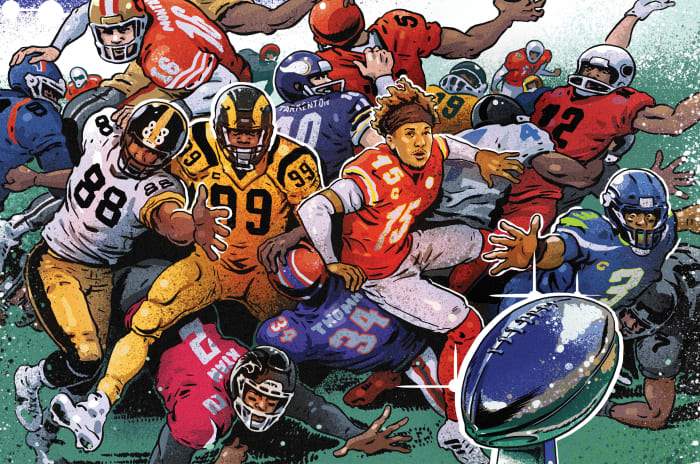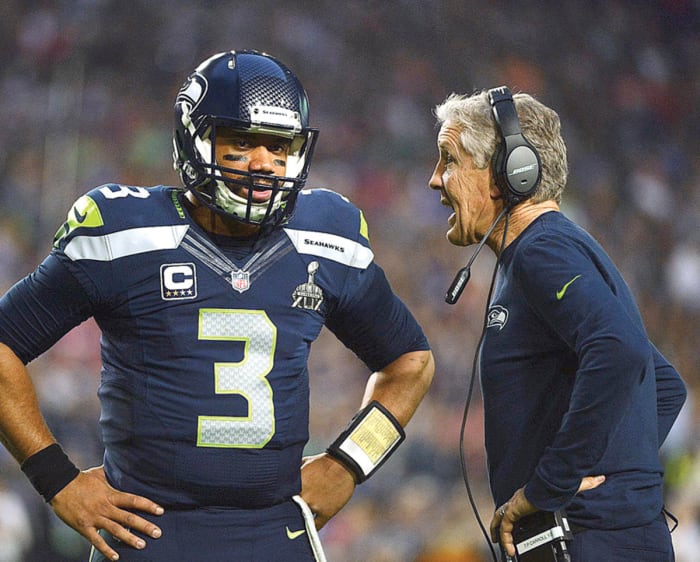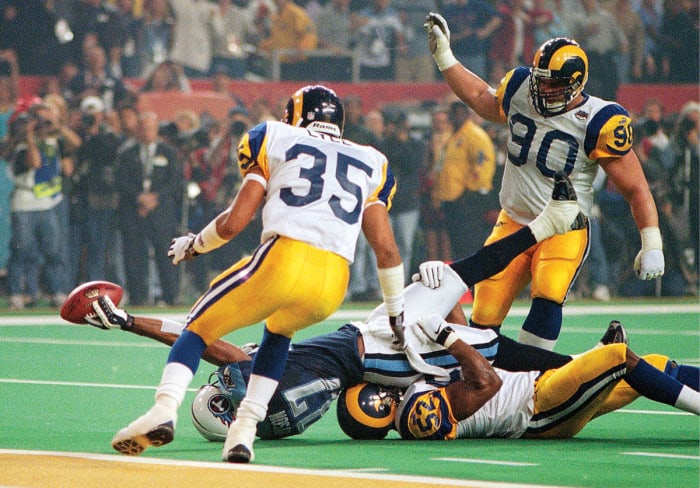At a Loss.
In the weeks and months and years that followed 28–3, Dan Quinn did everything to reconcile, compartmentalize and move past the worst 20 minutes in Super Bowl history, when the Falcons blew a lead to the Patriots to lose Super Bowl LI. As those three digits transformed into a synonym for choking on the grandest stage in sports, Quinn meditated every morning. He read books on grit, leadership and grief. He studied his team’s collapse, over and over—he always knew how the horror movie would end, but he watched until he also knew the villain’s outfit and precisely how much blood dripped from the knife.
The Atlanta coach also ate a lot of lunches with coworkers in the spring of 2017, dining out so often that he came to worry about his weight. He needed to check in with roughly 30 members of the organization, from ownership to roster cornerstones. The Falcons had blown the largest lead in Super Bowl history; they were close enough to smudge the Lombardi Trophy with their fingerprints before it all fell away. Quinn knew that most of his dining companions recognized a vague yet terrifying idea grounded in anecdotal rather than empirical evidence: Some call it a hangover, others a curse—either way, it marked impending doom for the NFL runner-up.
Over the first 50 Super Bowls, only seven teams that lost returned to the grand stage the next season—and the Bills of the early 1990s accounted for nearly half the total. And none of those 50 teams, of course, had stumbled quite like the Falcons against the Pats, who studded each of their championship rings with a 283-diamond reminder.
Quinn met with quarterback Matt Ryan, one of the steadier stars in football who needed to imprint his stoicism upon teammates. Quinn told offensive coordinator Kyle Shanahan that he had shouldered too much blame for the ineffective fourth-quarter play-calling, urging Shanahan to “get back that moment and prove that you can win.” Quinn explained to others the significant distinction between a wound and a scar: the wound new, open and painful; the scar healed, cool and numbed. The upcoming season, he insisted, would be its own entity, entirely separate from the previous one. Over the next four months, they would turn wounds into scars.
The coach tried every angle he could think of. He peddled positivity—the kind he had gleaned from his mentor, Pete Carroll, after the Seahawks won then lost a Super Bowl, in the 2013 and ’14 seasons. Quinn noted the accomplishment in simply reaching a championship, pointing out that the 1972 Dolphins compiled the only undefeated season in the Super Bowl era only after losing the title game the year before. (He didn’t mention they were the last runner-up to win it the next season.) The coach also reminded his players that they had chosen a competitor’s existence, and that sometimes competitors get their butts kicked. He paraphrased veteran NBA coach Doc Rivers: “You gotta be willing to get your heart broke, to be so emotionally in, to have a chance.”
Quinn understood the challenges that every championship game loser must confront: the emotional toll, the shorter offseason, the condensed recovery time, the challenge of re-creating the magic that made the run possible, the departure of key players and coaches. (Shanahan, for instance, left to take over the 49ers.) Quinn could still taste the glorious beers he had chugged, as the defensive coordinator, after Seattle’s triumph in Super Bowl XLVIII, still remember the bludgeoning bitterness after Russell Wilson’s late interception against those crafty Patriots in XLIX. He remained firm. “I don’t think there’s any curse,” he said then, and says now, and will say probably forever.
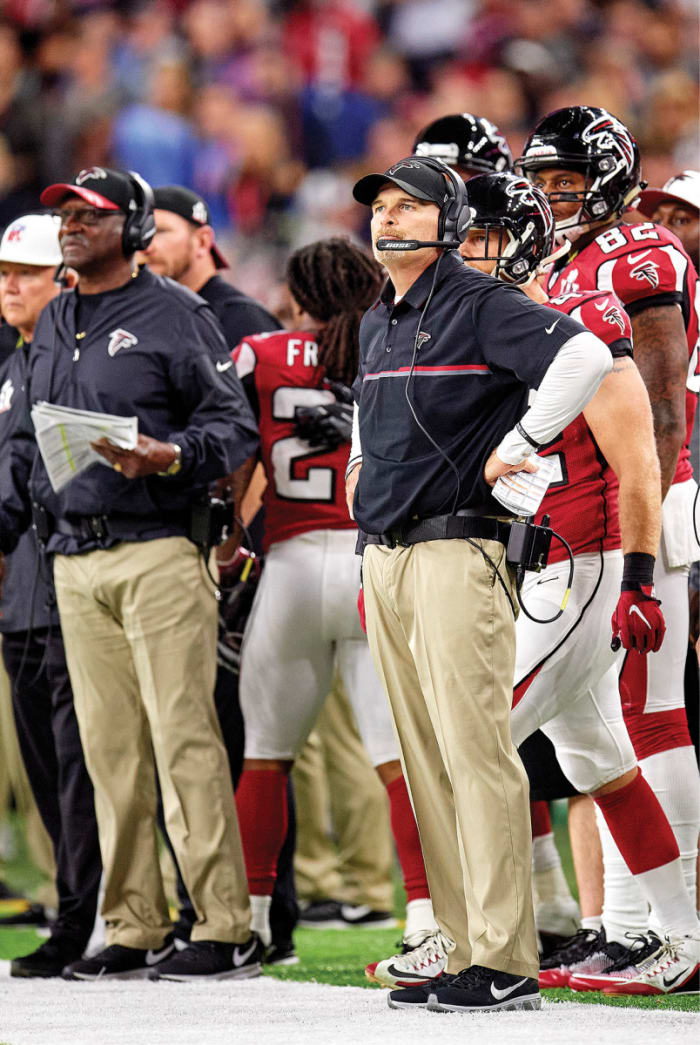
WORTH ANOTHER LOOK Quinn confronted his team’s Super Bowl heartbreak—and the Falcons won a playoff game the next season. But fewer than four years later, his tenure in Atlanta was over.
Robert Beck
In the weeks and months and years that followed 28–3, the Falcons suffered numerous injuries, lost quite a few games, made some bad signings, whiffed on some draft picks, botched simple kicks and blew games late. This was, in most ways, life in the NFL, but in their case each mistake was amplified because of the Super Bowl collapse; 28–3 had come to define them.
Quinn remains proud of the ’17 team that overcame a 4–4 start to return to the playoffs, where it toppled the Rams on the road and had a chance on the goal line in the final seconds to beat the eventual champion Eagles. But the Falcons have not had a winning campaign since, and, in 2020, they squandered five fourth-quarter leads (December included a 24–7 third-quarter advantage over Tom Brady’s Bucs that ended in a 31-27 defeat), as if haunted by the one they blew four seasons ago. Quinn was fired in October, and while he refuses to connect the confluence of fluky, miserable and sure-seems-meaningful events that ended his tenure, he will allow for the same sentiment that most Super Bowl losers subscribe to: In the following season(s) weird stuff happens, leading fans and outsiders to look for patterns in random events. Maybe they’re seeing ghosts. Maybe they’ve unearthed a profound truth.
In 2018, a Falcons fan named Jonathan Yaeger took a deep dive into losing Super Bowl teams. Like most fans, he knew the basics: The ’98 Falcons, who went 14–2, lost Super Bowl XXXIII and won nine games total over the next two seasons; the 2000 Giants, who dropped Super Bowl XXXV, didn’t make it past the wild-card round until ’07; the Raiders team that tripped up in XXXVII had scratched out one winning season since; the Bears went to Super Bowl XLI, lost to the Colts and finished last in their division a year later.
The Eagles, six months removed from their XXXIX disappointment, endured Terrell Owens’s knocking out driveway sit-ups while helicopters circled overhead, the tempestuous wideout fracturing the locker room before a 10-loss season under Andy Reid. “Losing sucks because you have regrets, doubts,” the quarterback of that team, Donovan McNabb, told Sports Illustrated last January. Before the interview that afternoon McNabb had stood before the Chiefs, Reid’s new team, and implored them to win so they wouldn’t feel the way he still felt—tortured, reliving the same two plays over and over, 15 years later. In one particularly rough stretch, between 1998 and 2007, many stars felt that way, as only two of those Super Bowl losers (the 1999 Titans, the 2005 Seahawks) returned to the postseason the next year. During that span, runners-up won an average of 12.6 games in the years they reached the Super Bowl, but just 7.6 the season after. Still, to Yaeger, a Georgia Tech alum with a degree in engineering, none of that suggested anything more than mere coincidence, the result of a small sample size.
Most Super Bowl hangover believers, he says, had not considered an obvious control group for comparison. They ignored the larger puzzle. The Patriots, of course, were an exception to any jinx, in that they seemed to return to the Super Bowl every season. But even the magnificent Tom Brady suffered his most significant injury the year after Giants receiver David Tyree pinned a football to his helmet to hand New England a Super Bowl defeat, and a season-ending, first game, first quarter, defender-falls-into-leg injury to a star quarterback seems a little curse-y.
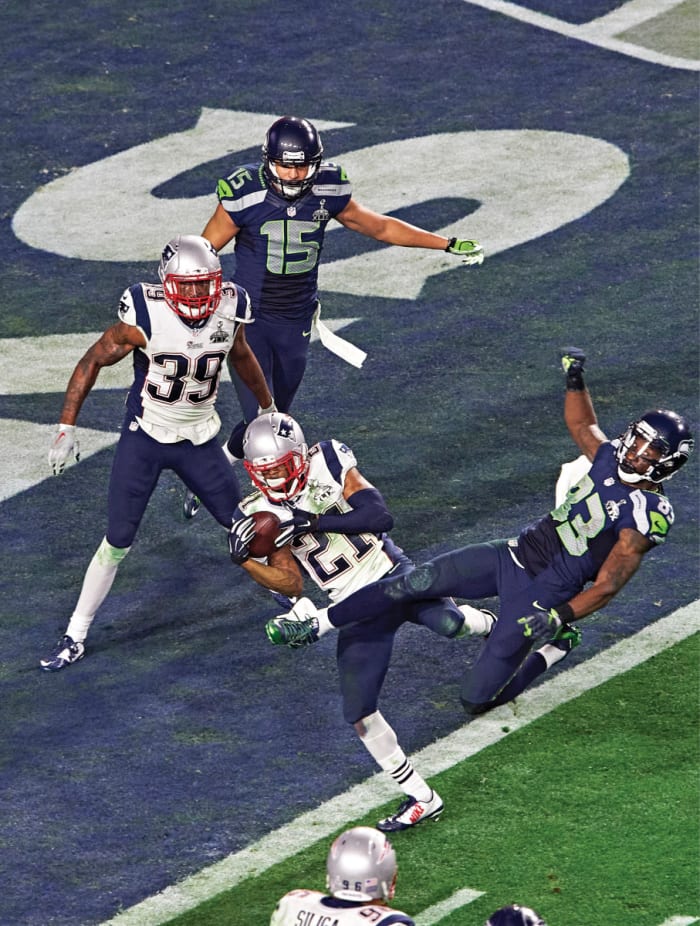
Seattle Settled The Malcolm Butler pick (top) in XLIX was the last pass the Seahawks threw in a Super Bowl, but Wilson and Carroll (below) have returned to the playoffs five times since.
JOHN IACONO
The Pats’ continued success started Yaeger down a research tunnel. He began digging into the rate at which Super Bowl winners performed the next season. At that point, in 2018, he found they won an average of 0.31 more games than the losers and produced only one additional division champ and fewer second-place teams. Meanwhile, the winners and losers made the playoffs at the same rate (70%), although the winners in general advanced deeper.
As for the hangover? It didn’t take an engineering degree for Yaeger to wonder how the high rate of return to the playoffs and the Super Bowl (14%) made for any sort of hangover or curse. Shouldn’t all teams be that unlucky?
Super Bowl losers attempting to turn wounds into scars often follow two distinct approaches: Either they try to speed the healing by addressing the wound directly, or they ignore the wound until it scabs over naturally. In recent years, most teams leaned on the heal-it-immediately approach, hiring consultants who focused on performance, mental health and holistic healing.
After Wilson’s interception, Carroll brought in guest speakers throughout the spring of 2015, often choosing those who had overcome public and embarrassing defeats. Like Du-Shaunt Stegall, a professional dancer known as Fik-Shun who, after falling on his face during a nationally televised competition, canceled gigs and considered retirement before accepting what had happened and moving forward. That summer, the coach told SI that examining the depths of his own pain had been “thrilling.”
“You’ll never know,” Carroll said. “I can’t make you understand. You pour everything in your life into something and—it goes right, it goes wrong—it’s in you. It becomes part of you.” The Seahawks reached the playoffs in five of the next six seasons, including that one. The Falcons, under Carroll’s protégé Quinn, took a similar tack and won that playoff game the following season. In fact, since 2010, Super Bowl bridesmaids compiled a 110–66 collective record the season after. Eight of those 11 teams made the playoffs.
And yet, one team took a contrary approach, because that one team always does. Randy Cross, the three-time Super Bowl champion offensive lineman with the 49ers, would travel to One Patriot Place for TV broadcast gigs, and he never detected any acknowledgement of a previous season: That meant not only no Super Bowl rings or trophies, but also nobody lamenting a championship game loss, either. “It’s like,” Cross says, “they would physically just ignore anything that had anything to do with the year before.”
Cross became a radio host and settled in Atlanta, where fans have lamented the hangover as if they were looking to confirm it. Cross notes that the team still played at a high level the following season. But weren’t the Patriots actually right? Didn’t obsessing about a curse in some ways perpetuate it? Or: Was the actual curse as simple as lacking the advantage that was Brady and Bill Belichick?
Cross watched this offseason as the Niners started yapping about a revenge tour after losing the last Super Bowl, to those Chiefs that McNabb addressed. “Nah, man,” Cross thought, “that ain’t gonna end well.”
He had no earthly idea the weird stuff yet to come.
San Francisco GM John Lynch called on the last day of 2020 from a Marriott in Arizona, his team’s temporary home since a Thanksgiving-weekend ban on contact sports in Santa Clara County, home to the 49ers’ headquarters and stadium. The team found out about the ban on a bus headed to a game against the Rams, giving officials roughly 48 hours to relocate all operations across state lines. For the latest franchise to lose a Super Bowl, the move registered as just one more hiccup in this, the strangest of seasons. One that Lynch, while careful not to make excuses, would prefer never to repeat. “Yeah, this is not ideal,” he says of the team’s nomadic existence.
Last February in Miami, Lynch skipped down to the field hoping to celebrate a 49ers triumph. As he settled onto the sideline San Francisco led by 10 in the final quarter, and Kansas City faced a steep third-and-15 against the NFL’s best defense. The Chiefs converted on an improbable heave from Patrick Mahomes to Tyreek Hill and won with a comeback that wasn’t 28–3 but was close. Crushed, Lynch forced himself to go to the postgame party, which was about as festive as a review of the employee handbook with human resources. The GM found his coach, Kyle Shanahan, the former Falcons coordinator who had just missed the redemption he spent three years maniacally chasing. Quinn had texted Shanahan that week, writing, in part, “Let it Rip like a motherf-----!!!!!!” Shanahan had. With the exact same result. “Bouncing back shouldn’t be a problem,” Shanahan told reporters.
Lynch knew his team had the right foundation, but he wasn’t so sure about the bounce back. As a Hall of Fame safety who spent his prime in Tampa, he saw up close the challenges even Super Bowl winners must confront. Lynch remembers then–Buccaneers coach Jon Gruden, after winning Super Bowl XXXVII, lamenting how many players started radio shows before the start of the next season. “Does anybody else want one?” Gruden boomed. Lynch thought the Bucs had a better team in 2003, but they finished 7–9, and he suffered his first “real bad” stinger against the Colts that marked “the start of my demise.” As he transitioned into personnel, Lynch sometimes studied Belichick at the NFL scouting combine, noting the Patriots’ “skeleton crew” at the event, allowing key staffers to recover after inevitably longer seasons.
The day after the loss, the Niners held a team meeting. An emotionally spent Shanahan ceded the floor to Lynch, who—prompted by a text from Hall of Fame quarterback Kurt Warner, a winner of one Super Bowl and loser in two others—told players they should celebrate a special season, even if it didn’t feel that way right then. Lynch also went through the history of Super Bowl–losing teams that didn’t play football in New England. “We believe we’re different,” he said. “Let’s go show it.”
It’s never easy, of course, to keep a team together, form the same connective tissue, stay just as healthy, seize the same breaks. Due to a salary-cap crunch Lynch had to trade All-Pro defensive lineman DeForest Buckner to the Colts. He couldn’t afford to retain wideout Emmanuel Sanders, who signed with the Saints. The Niners faced the NFC’s toughest schedule, but Vegas oddsmakers remained bullish, giving them the third-best odds (9-to-1, trailing the Chiefs and Ravens) to win the Super Bowl. “We felt we had done some things where, on paper, we might even be a better team,” Lynch says.
He’ll never know. In 2020, an NFL-record $80 million worth of 49ers landed on injury reserve or were inactive due to injury or COVID-19 protocols. Eighty-four players took at least one snap, while 53 started on offense or defense. Three opted out of this pandemic season before camp started. In Week 2 alone, the 49ers took on the Jets without a host of injured starters (George Kittle, Richard Sherman, Dee Ford and Deebo Samuel), and, in one haunted afternoon against the Jets, they lost Jimmy Garoppolo, Nick Bosa, Raheem Mostert and Solomon Thomas to injuries at MetLife Stadium. That’s not a few missing players. That’s half a Pro Bowl roster watching games from the same suite. “Just a bloodbath,” Lynch says.
With a date against the Giants in the same stadium a week later, the Niners stayed in West Virginia, rather than crisscrossing the country; they even hired their own MRI truck to handle scans. The truck, of course, broke down.
All that happened before the positive COVID-19 tests, before San Francisco was forced to finish the season in Arizona, before players impressed Lynch with their unending fortitude, despite the 6–10 mark. Thank God I played in the defensive backfield, Lynch thought, where coaches trained him to forget the worst of football—like a third-and-15 conversion in the Super Bowl—and move on to the next play.
Cursed? No, Lynch says. He’s blessed with a foundation that can be easily replenished for another run in 2021. He’s like Kevin Sherman, whose son Richard has one ring but lost two other Super Bowls, one on the Mahomes comeback and the other on the Wilson interception—“I don’t think I’ve ever gotten over it,” Kevin says. He calls the 2020 49ers’ transformation into a MASH unit without a home “just a fluky type of deal.” Weird stuff happens. “It’s like it’s nobody’s fault,” Papa Sherman says. But a season like that sounds a lot like a cur . . . “Nope,” he says. “2020 doesn’t count.”
Kevin Dyson knows what it’s like to wrestle ghosts, to try to explain what’s impossible to understand for someone who hasn’t lived it. That’s how many come to believe in curses, for the tidy explanation they offer. Dyson caught 18 touchdown passes for two NFL franchises and yet will always be defined by two plays with the Titans from the 1999 season: the Music City Miracle and the Tackle. First, Dyson caught a disputed lateral on a kickoff return and sped 75 yards into the end zone to upend the Bills in the final seconds of a wild-card matchup. Just 22 days later, he was stopped one yard short of scoring the game-winning touchdown against the Rams in Super Bowl XXXIV.
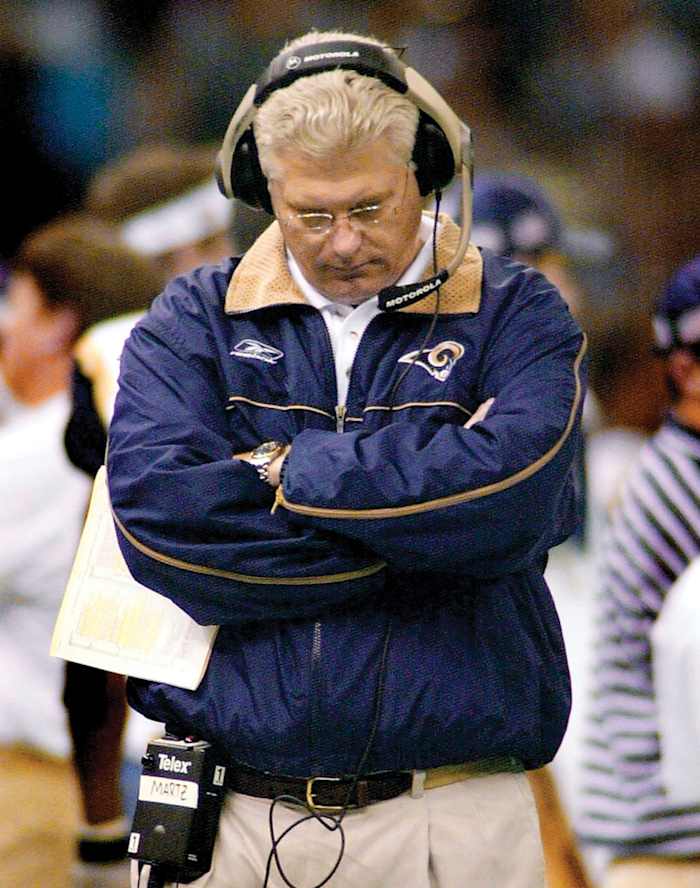
ST. LOUIS’S ARC Martz (above) and the Rams lost two years after they tackled Dyson one yard short (below).
PETER MUHLY/AFP/Getty Images
His first canker sore appeared a day or two after a defeat as heartbreaking as the 28–3 collapse. But then came a second sore, then five, then 10. By the time the count reached 22, Dyson visited the doctor, overcome by stress. The nurse who treated him looked as if she wanted to cry. She had to burn them off, one by one. “It was just how my body dealt with, I guess, an emotional loss,” Dyson says now.
The feeling never really left him, a professional athlete who before the last seconds of that Super Bowl had always delivered in the final moments—the Miracle in Nashville being the latest example. Now, for the first time, “I felt like I let the city down,” he says.
Dyson spent the next six months training harder, skipping vacations, determined to earn redemption. “You look at the paradox of, wow, you’re not even supposed to be part of the Super Bowl, but you had this wild play to get there, and then when you get to the biggest game of your life, you don’t score,” he says. The canker sores were a physical manifestation of the mental toll inflicted by losing just one game, the one game being just that important.
Hangover? Dyson laughs. No way. He points out that Tennessee went 13–3 the next season. If anything, the Canker Sore Curse was isolated to Dyson alone, as he completed only one healthy season in his final four years, never getting back to the big one. But as he watched the Falcons crumble while ahead 28–3, he thought they would come back from a defeat as epic as his own. He hoped they would, at least.
Those same Rams, the ones that beat Dyson by three feet of green turf defended, would lose their own Super Bowl two seasons later (XXXVI, against the Patriots, as Tom Brady for the first time became Tom Brady). The next season they went 7–9 and missed the playoffs. Like Carroll, Quinn and Dyson, the coach of that St. Louis team, Mike Martz, says the sting “never goes away,” adding that he never watched the defeat again after grading his players in the aftermath. But if there’s any curse involved—he certainly wouldn’t call it that—it’s the salary cap. Teams like the Rams often marshal resources, like poker pros pushing all their chips toward the center of the table, for one last run. The All-in Curse.
Most football aficionados remember those Rams by the nickname for their offense, the Greatest Show on Turf, led by Hall of Famers like Warner and Marshall Faulk. They had reached two Super Bowls in three years, and that meant bigger contracts for more players. And that meant less flexibility in the years ahead. Those 2002 Rams would lose several defensive starters, including middle linebacker London Fletcher, a player Martz describes as the Warner of his defense, one of two or three players “most vital to our success.”
In his six years with the franchise, the ’02 season marked Martz’s only full losing season. It wasn’t surprising. It was football, a convoluted sport designed like a Rube Goldberg machine, where dozens of variables—90 players, scheme, weekly game plans, health, weather—must sync perfectly. Catastrophe on two dozen of the more than 1,000 snaps each team runs over the course of a season can be the difference between a Super Bowl run and a losing record. Injuries happen. So do free-agent departures. That the ’01 Rams went for it, knowing the dismantling ahead, spoke more to calculated risk, their best—and maybe last—chance to make another run with that group. Their ’02 hangover was a function of the NFL’s natural order. Curse? Martz, too, laughs. “We lost a lot of good players.”
Then he pivots, back toward an old foe. “It’s like the situation up in New England right now,” Martz says of the Patriots, who finished 7–9 this season. “They mortgaged so many years so they could [try to] win Super Bowls. But eventually, you’re gonna have to pay the price.” In other words, weird stuff happens because weird stuff is supposed to happen in the NFL.
Going all in and coming up short is one problem. The other: not doing enough. There’s a delusion grounded in being so close—in Dyson’s case, one yard; in Quinn’s, one quarter—to winning that one specific game.
A performance consultant like Mike Forde (Chelsea Football Club, San Antonio Spurs, various NFL teams) sees this mistake often, and not just in the NFL. Especially for older teams, or teams that have been close repeatedly, there’s a tendency to make fewer changes than necessary.The coaches who do that aren’t listening to themselves when they say that each season is its own entity. They’re too loyal, Forde says, too hopeful, which can make a coach and front office ignorant of the team’s deficiencies.“There’s an over-reliance to keep the band together and have another run at it,” he says. Call it the Curse of Wishful Thinking. “You’ve got to look at the next season in isolation, which is hard because there’s a human capital, emotional aspect to it that wants [teams] to believe in the magic,” Forde says.
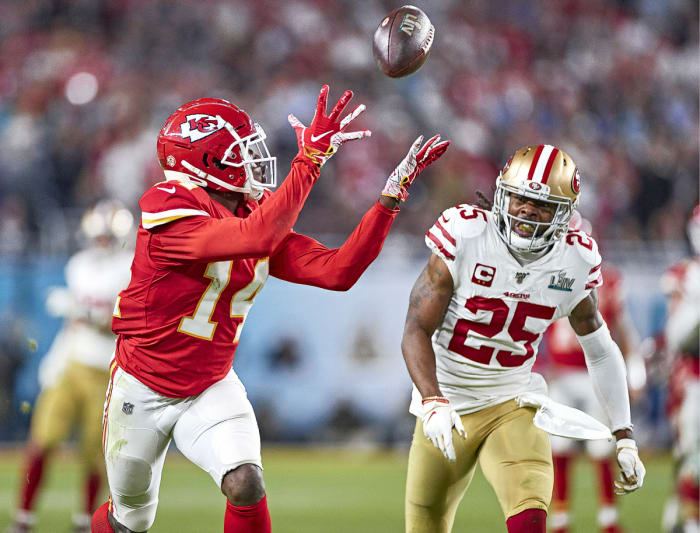
THE OTHER ONE THAT GOT AWAY Sherman (25) suffered his second Super Bowl defeat last February, then was among the many San Francisco stars who missed the majority of 2020 due to injury.
Simon Bruty
Richard Thaler, the 2017 Nobel Prize winner in economic sciences and longtime professor at the University of Chicago Booth School of Business, once cowrote a deep research paper on decision-making at the NFL draft. He came to view the overvaluing of early selections as the “most blatant violation of market efficiency” he had witnessed in his long and celebrated career.
Teams operate inefficiently, Thaler found, and that extends to their thought process concerning the Super Bowl itself: They overvalue a single game. Was Eli Manning really a better quarterback than Dan Marino, as some pundits posited, because he won two Super Bowls and Marino never won a title? When both of Manning’s rings resulted from catches that bordered on miraculous? It’s something known as counterfactual thinking. Teams compare their feats to what might have been, rather than what actually was. The Bills should view their run of four straight Super Bowl appearances—all losses—as historically great. But none of them do.
The weird stuff that happens? It can be partly psychological. But even Thaler says, “I would be shocked if there was anything more to the Super Bowl losing curse than to the Sports Illustrated [cover jinx].”
All of which leads us back to the same place, to 28–3 and the Falcons’ collapse to end all collapses. Jason Pauley, who worked for six years as a locker room manager for the team on game days (but still rooted for the Giants) quit his full-time job at IBM in 2017 and took a year off. With ample free time and a background in data analysis, he dove even deeper into the statistics of Super Bowl losers.
Like Yaeger, Pauley started with a control group of the first 50 Super Bowl winners and found them strikingly similar to the teams that lost. But he didn’t stop there. Attempting to quantify the emotional component, he split the losers into four categories: teams that lost in blowouts, in convincing defeats, in close games (defined by one score) and in games decided after the final two-minute warning. Teams in the “close game” category made the playoffs the following year more often (86%) but came from the smallest sample size (seven Super Bowls). Each of the other categories had return rates above 64%; as a whole, 70% of losing Super Bowl teams got back to the playoffs the next year.
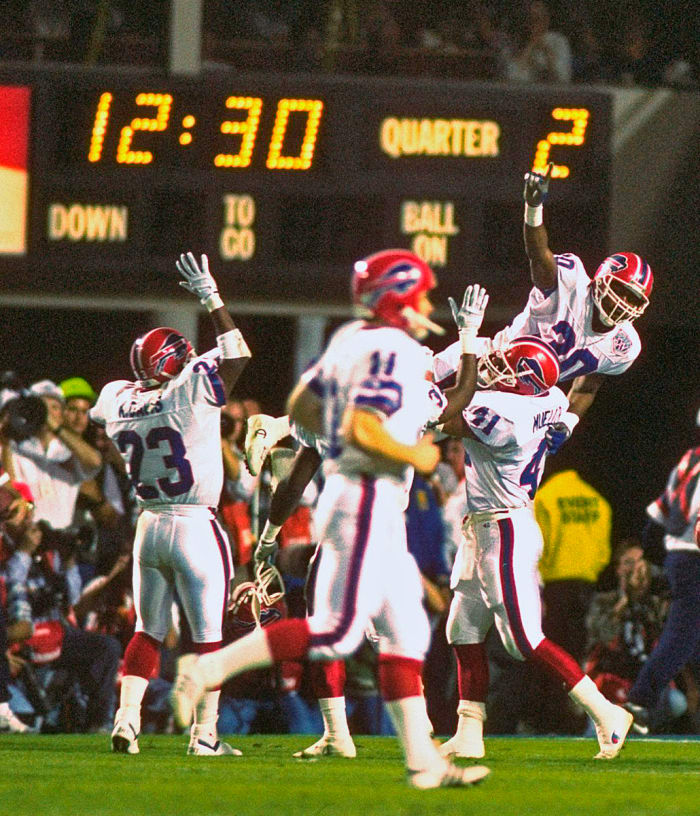
BILL’D UP The early-’90s Buffalo teams should be celebrated for their unprecedented run of success, but instead became defined by four straight losses.
Richard Mackson
Next, Pauley wondered how other playoff teams, the ones that didn’t make the Super Bowl, fared in the following season. He found that they made the postseason at a much lower clip (53%). To factor in the likelihood that playoff teams have better chances the next season, due to returning players and postseason experience, he examined squads that won 12 or 13 games in any season but did not reach the Super Bowl. They returned to the playoffs at a 51% rate. The Super Bowl teams, even the losing ones, boasted the highest rate of return to the playoffs.
Ultimately, Pauley came to believe that the NFL playoffs represent a simple mathematical concept: regression to the mean. The outliers—teams that won far more games (for instance, 14–2 teams) or fewer (2–14 ones) than the mean—tended to fall closer to the league average the next season, due to factors like a year of good health turning bad, a tough schedule, or a couple of bad bounces in games that often come down to a handful of plays. This is parity, more or less—the very parity the NFL tweaked its rules for decades to achieve.
As for the Super Bowl hangover for the losers, or a curse on the teams that don’t make it back, Pauley suggests a simple, declarative conclusion: There isn’t one.
